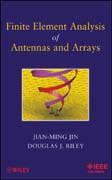
Antenna technologies have received renewed interest because of the rapid development of wireless devices and advanced defense applications. Consequently, highly accurate and efficient modeling and simulation tools are needed to satisfy the demand for sophisticated antenna designs. Finite Element Analysis of Antennas and Arrays covers all the technical aspects in the analysis of complex antennas and arrays using the finite element method. INDICE: Preface. Acknowledgments. Chapter 1: Introduction. 1.1 Numerical Simulation of Antennas. 1.2 Finite Element Analysis vs. Other Numerical Methods. 1.3 Frequency- vs. Time-Domain Simulations. 1.4 Brief Review of Past Work. 1.5 Overview of This Book. References. Chapter 2: Finite Element Formulation. 2.1 Finite Element Formulation in the Frequency Domain. 2.2 Finite Element Formulation in the Time Domain. 2.3 Modeling of Complex Materials. 2.3.1 Modeling of Electrically and Magnetically Lossy Materials. 2.3.2 Modeling of Electrically Dispersive Materials. 2.3.3 Modeling of Magnetically Dispersive Materials. 2.3.4 Modeling of Doubly Dispersive Lossy Materials. 2.4 Solution of the Finite Element Equations. 2.5 Higher-Order and Curvilinear Finite Elements. 2.6 Summary. References. Chapter 3: Finite Element Mesh Truncation. 3.1 Absorbing Boundary Conditions. 3.1.1 First-Order Absorbing Boundary Condition. 3.1.2 Second-Order Absorbing Boundary Condition. 3.2 Perfectly Matched Layers. 3.2.1 PML in Terms of Stretched Coordinates. 3.2.2 PML as an Anisotropic Material Absorber. 3.2.3 PML for Truncating Computational Domain. 3.2.4 Finite Element Implementation of PML. 3.2.5 ABC-Backed, Complementary, CFS, and Second-Order PMLs. 3.3 Boundary Integral Equations. 3.3.1 Frequency-Domain Formulations. 3.3.2 Time-Domain Formulations. 3.3.3 Treatment of Infinite Ground Plane. 3.4 Summary. References. Chapter 4: Hybrid FETD-FDTD Technique. 4.1 The FDTD Method. 4.2 PML Implementation in FDTD. 4.2.1 FDTD Stretched-Coordinate PML. 4.2.2 FDTD Anisotropic PML. 4.3 Near-to-Far-Field Transformation in FDTD. 4.4 Alternative FETD Formulation. 4.5 Equivalence between FETD and FDTD. 4.6 Stable FETD-FDTD Interface. 4.6.1 Initial Approaches. 4.6.2 Stable Formulation. 4.7 Building Hybrid Meshes. 4.8 Wave-Equation Stablization. 4.9 Validation Examples. 4.10 Summary. References. Chapter 5: Antenna Source Modeling and Parameter Calculation. 5.1 Antenna Feed Modeling. 5.1.1 Current Probe. 5.1.2 Voltage Gap Generator. 5.1.3 Waveguide Feed Model. 5.2 Plane-Wave Excitation. 5.2.1 Total-Field Formulation. 5.2.2 Scattered-Field Formulation. 5.2.3 Total- and Scattered-Field Decomposition Approach . 5.3 Far-Field Pattern Computation. 5.4 Near-Field Visualization. 5.5 Summary. References. Chapter 6: Modeling of Complex Structures. 6.1 Thin Material Layers and Sheets. 6.1.1 Impedance Boundary Conditions. 6.1.2 Shell Element Formulation. 6.2 Thin Wires and Slots. 6.2.1 Thin Wires. 6.2.2 Thin Slots. 6.3 Lumped Circuit Elements. 6.3.1 Coupled First-Order Equations. 6.3.2 Wave Equation. 6.3.3 Example. 6.4 Distributed Feed Network. 6.5 System-Level Coupling Example. 6.5.1 Internal Dispersive Material Calibration. 6.5.2 External Illumination and Aperture Coupling. 6.6 Summary. References. Chapter 7:Antenna Simulation Examples. 7.1 Narrowband Antennas. 7.1.1 Coaxial-fed Monopole Antenna. 7.1.2 Monopole Antennas on a Plate. 7.1.3 Patch Antennas on a Plate. 7.1.4 Conformal Patch Antenna Array. 7.2 Broadband Antennas. 7.2.1 Ridged Horn Antenna. 7.2.2 Sinuous Antenna. 7.2.3 Logarithmic Spiral Antenna. 7.2.4 Inverted Conical Spiral Antenna. 7.2.5 Antipodal Vivaldi Antenna. 7.2.6 Vlasov Antenna. 7.3 Antenna RCS Simulations. 7.3.1 Microstrip Patch Antenna. 7.3.2 Standard Gain Horn Antenna. 7.4 Summary. References. Chapter 8: Axisymmetric Antenna Modeling. 8.1 Method of Analysis. 8.1.1 Finite Element Formulation. 8.1.2Mesh Truncation Using Perfectly Matched Layers. 8.1.3 Mesh Truncation Using Boundary Integral Equations. 8.2 Application Examples. 8.2.1 Luneburg Lens. 8.2.2 Corrugated Horn. 8.2.3 Current Loop Inside a Radome. 8.3 Summary. References. Chapter 9: Infinite Phased Array Modeling. 9.1 Frequency-Domain Modeling. 9.1.1 Periodic Boundary Conditions. 9.1.2 Mesh Truncation Techniques. 9.1.3 Extension to Skew Arrays. 9.1.4 Extension to Scattering Analysis. 9.1.5 Application Examples. 9.2 Time-Domain Modeling. 9.2.1 Transformed Field Variable. 9.2.2Mesh Truncation Techniques. 9.2.3 General Material Modeling. 9.2.4 Application Examples. 9.3 Approximation to Finite Arrays. 9.4 Summary. References. Chapter 10: Finite Phased Array Modeling. 10.1 Frequency-Domain Modeling. 10.1.1 The FETI-DPEM1 Formulation. 10.1.2 The FETI-DPEM2 Formulation. 10.1.3 Nonconforming Domain Decomposition. 10.1.4 Application Examples. 10.2 Time-Domain Modeling. 10.2.1 The Dual-Field Domain Decomposition Method. 10.2.2 Domain Decomposition for Iterative Solutions. 10.2.3 Application Examples. 10.3 Summary. References. Chapter 11: Antenna-Platform Interaction Modeling. 11.1 Coupled Analysis. 11.1.1 FETI-DPEM with Domain Decomposition. 11.1.2 Hybrid FETD-FDTD with Domain Decomposition. 11.1.3 Hybrid FE-BI Method with FMM Acceleration. 11.2 Decoupled Analysis. 11.2.1 Near-Field Calculation. 11.2.2 Far-Field Evaluation byNumerical Methods. 11.2.3 Far-Field Evaluation by Asymptotic Techniques. 11.2.4 Direct and Iterative Improvements. 11.3 Summary. References. Chapter 12: Numerical and Practical Considerations. 12.1 Choice of Simulation Technologies. 12.2 Frequency- vs. Time-Domain Simulation Tools. 12.3 Fast Frequency Sweep. 12.4 Numerical Convergence. 12.5 Domain Decomposition and Parallel Computing. 12.6 Verification and Validation of Predictions. 12.7 Summary. References. Index.
- ISBN: 978-0-470-40128-6
- Editorial: John Wiley & Sons
- Encuadernacion: Cartoné
- Páginas: 436
- Fecha Publicación: 09/01/2009
- Nº Volúmenes: 1
- Idioma: Inglés
